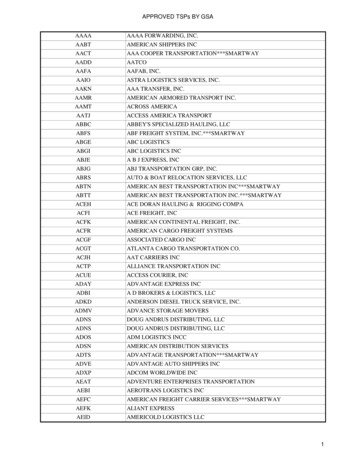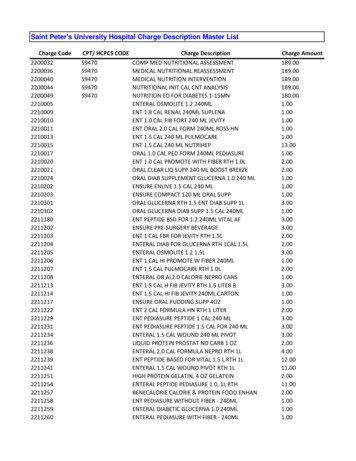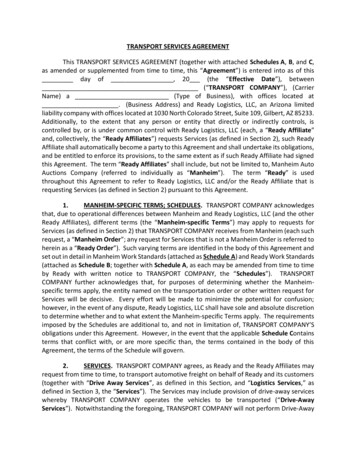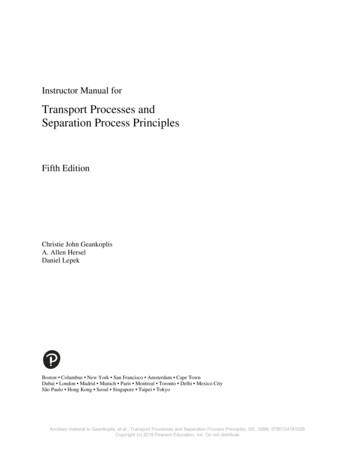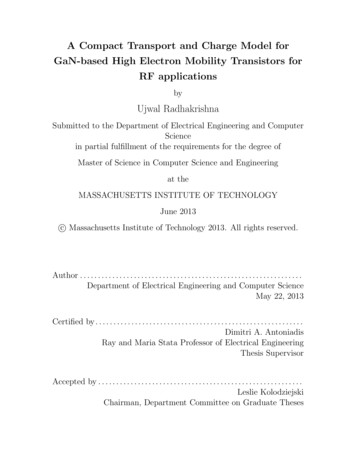
Transcription
A Compact Transport and Charge Model forGaN-based High Electron Mobility Transistors forRF applicationsbyUjwal RadhakrishnaSubmitted to the Department of Electrical Engineering and ComputerSciencein partial fulfillment of the requirements for the degree ofMaster of Science in Computer Science and Engineeringat theMASSACHUSETTS INSTITUTE OF TECHNOLOGYJune 2013c Massachusetts Institute of Technology 2013. All rights reserved.Author . . . . . . . . . . . . . . . . . . . . . . . . . . . . . . . . . . . . . . . . . . . . . . . . . . . . . . . . . . . . . .Department of Electrical Engineering and Computer ScienceMay 22, 2013Certified by . . . . . . . . . . . . . . . . . . . . . . . . . . . . . . . . . . . . . . . . . . . . . . . . . . . . . . . . . .Dimitri A. AntoniadisRay and Maria Stata Professor of Electrical EngineeringThesis SupervisorAccepted by . . . . . . . . . . . . . . . . . . . . . . . . . . . . . . . . . . . . . . . . . . . . . . . . . . . . . . . . .Leslie KolodziejskiChairman, Department Committee on Graduate Theses
2
A Compact Transport and Charge Model for GaN-basedHigh Electron Mobility Transistors for RF applicationsbyUjwal RadhakrishnaSubmitted to the Department of Electrical Engineering and Computer Scienceon May 22, 2013, in partial fulfillment of therequirements for the degree ofMaster of Science in Computer Science and EngineeringAbstractGallium Nitride (GaN)-based high electron mobility transistors (HEMTs) are rapidlyemerging as front-runners in high-power mm-wave circuit applications. For circuitdesign with current devices and to allow sensible future performance projections fromdevice engineering in such a rapidly evolving technology, compact device models areessential.In this thesis, a physics-based compact model is developed for short channel GaNHEMTs. The model is based on the concept of virtual source (VS) transport originally developed for scaled silicon field effect transistors. Self-consistent current andcharge expressions in the model require very few parameters. The parameters havestraightforward physical meanings and can be extracted through independant measurements. The model is implemented in Verilog-A and is compatible with state ofthe art circuit simulators. The new model is calibrated and validated with experimental DC I-V and S-parameter measurements of fabricated devices. Using the model, aprojection of cut-off frequency (fT ) of GaN-based HEMTs with scaling is performedto highlight performance bottlenecks.Thesis Supervisor: Dimitri A. AntoniadisTitle: Ray and Maria Stata Professor of Electrical Engineering3
4
AcknowledgmentsI would like to express my gratitude to my guru Prof. Antoniadis. His remarkableinsight in the field of semiconductors and many other things intrigue me every time.Hopefully one day many decades later, I will be able to achieve some degree of thatexpertise. I would like to express my sincere thanks to Prof. Palacios, whose effortsin GaN technology at MIT is the reason I could do research in this area. Meetingswith him always help me see the bigger picture. I would also like to thank Dr. LanWei, the amazing post-doc in our group who made my first year here at MIT seemtoo easy. Her take on this subject made me love device physics even more.Compact modeling of devices is meaningless without validation against devicesimulations or device measurements. I would like to thank Dong Seup Lee for fabricating for us, the best behaved state of the art devices. It was a pleasure modelingthem. I would also like to thank Han Wang for providing the base TCAD simulationdeck. I am very grateful to Jamie and Omair for helping me with measurements inour labs. I also thank Winston for the long and interesting conversations we have onvarious GaN related topics.Semiconductor physics would have been just another topic of my interest, if myundergraduate mentors at IIT-Madras, Profs. Amitava Dasgupta, Nandita Dasguptaand Anjan Chakravorty had not guided me. I will be always grateful for the foundation that they gave me in this area.I am very grateful for all my friends here at MIT and outside. Thank you Jaffas.Finally, I would like to deeply thank my appa, amma and tamma for always beingthere for me and for supporting my seemingly irrational decision of pursuing graduatestudy.5
6
Contents1 Introduction151.1Gallium Nitride technology: A brief history. . . . . . . . . . . . . .151.2GaN: Material properties and applications . . . . . . . . . . . . . . .161.3Thesis outline and goals . . . . . . . . . . . . . . . . . . . . . . . . .192 GaN HEMT: Operating principle2.12.22.321Basics of device operation . . . . . . . . . . . . . . . . . . . . . . . .212.1.1Generic HEMT structure . . . . . . . . . . . . . . . . . . . . .212.1.2GaN HEMT operation : Charge . . . . . . . . . . . . . . . . .222.1.3GaN HEMT operation : Transport . . . . . . . . . . . . . . .232.1.4Physical effects unique to GaN. . . . . . . . . . . . . . . . .25DC and RF figures of merit . . . . . . . . . . . . . . . . . . . . . . .272.2.1DC parameters . . . . . . . . . . . . . . . . . . . . . . . . . .272.2.2RF parameters . . . . . . . . . . . . . . . . . . . . . . . . . .28Device under study . . . . . . . . . . . . . . . . . . . . . . . . . . . .313 GaN compact models: Overview333.1Angelov model . . . . . . . . . . . . . . . . . . . . . . . . . . . . . .333.2Curtice model . . . . . . . . . . . . . . . . . . . . . . . . . . . . . . .363.3EEHEMT model . . . . . . . . . . . . . . . . . . . . . . . . . . . . .373.4Comparison of GaN models . . . . . . . . . . . . . . . . . . . . . . .404 The MVSG-RF model427
4.1Intrinsic transistor model . . . . . . . . . . . . . . . . . . . . . . . . .434.1.1Saturation regime (High VDSi ) . . . . . . . . . . . . . . . . . .444.1.2Non-saturation regime . . . . . . . . . . . . . . . . . . . . . .464.1.3GaN specific effects . . . . . . . . . . . . . . . . . . . . . . . .47Access regions . . . . . . . . . . . . . . . . . . . . . . . . . . . . . . .484.2.1Long channel access transistor model . . . . . . . . . . . . . .504.2.2The implicit-gate . . . . . . . . . . . . . . . . . . . . . . . . .524.3Gate diode model . . . . . . . . . . . . . . . . . . . . . . . . . . . . .544.4Channel charge model . . . . . . . . . . . . . . . . . . . . . . . . . .554.25 Experimental verification of MVS-G-RF model575.1Validation of access region model . . . . . . . . . . . . . . . . . . . .575.2Validation of MVS-G-RF DC model . . . . . . . . . . . . . . . . . . .595.3Validation of charge model . . . . . . . . . . . . . . . . . . . . . . .625.3.1S-parameter measurements . . . . . . . . . . . . . . . . . . . .625.3.2Extraction of fringing capacitances . . . . . . . . . . . . . . .635.3.3Gate capacitance: model vs. measurements . . . . . . . . . . .655.4Unity current gain frequency (fT ) . . . . . . . . . . . . . . . . . . . .665.5Technology projections: gm and fT. . . . . . . . . . . . . . . . . . .685.5.1gm projection . . . . . . . . . . . . . . . . . . . . . . . . . . .685.5.2fT projection . . . . . . . . . . . . . . . . . . . . . . . . . . .696 Summary and future work71A Model parameter extraction73A.1 Device parameters . . . . . . . . . . . . . . . . . . . . . . . . . . . .74A.2 Cinv extraction . . . . . . . . . . . . . . . . . . . . . . . . . . . . . .74A.3 Extraction of VT o , S, nd and δ . . . . . . . . . . . . . . . . . . . . . .75A.4 Extraction of vinj , β and θv , θµ , ηv and ηµ . . . . . . . . . . . . . . .76B Model parameters79B.1 Model parameters for TLMs . . . . . . . . . . . . . . . . . . . . . . .879
B.2 Model parameters for GaN HEMTs . . . . . . . . . . . . . . . . . . .980
10
List of Figures1-1 Number of publications (based on INSPEC search) and milestones ofGaN research [1]. GaN research in both optoelectronics and electronicsprogressed rapidly after demonstrating the growth of high quality GaNand conductivity control of both p- and n-type GaN in the early 1990s. 161-2 Table showing material properties. GaN shows a combination of highelectron mobility, electron velocity and breakdown field [2] . . . . . .171-3 Projection of the role of GaN on Si platform in IR’s market [3]. TheFoM (’efficiency density/ cost’ ) is sustained in future through GaNbased technologies. . . . . . . . . . . . . . . . . . . . . . . . . . . . .181-4 Ron vs. BV tradeoff for Si, GaN and SiC. For a given BV GaN showssignificantly lower Ron [3] . . . . . . . . . . . . . . . . . . . . . . . . .192-1 A rough schematic of a typical GaAs based HEMT heterostructure .222-2 (a) Device structure schematic (b) Band diagram of heterostructureshowing different types of charges . . . . . . . . . . . . . . . . . . . .232-3 Velocity-field profile of GaN HEMTs; MC simulation and measurements 242-4 Velocity-field profile assumed in MVS-G-RF model . . . . . . . . . .252-5 Structure schematic showing different regions of interest (a) red-intrinsictransistor (b) green- access regions . . . . . . . . . . . . . . . . . . .262-6 Schematic showing the reason for dynamic Ron effects. Electrons fromthe gate compensate the positive donor states creating depletion regionin the 2DEG at drain edge of the gate thereby increasing Ron . . . . .272-7 Simplified circuit for RF FoM extraction . . . . . . . . . . . . . . . .2911
2-8 BV vs. fT trade off for different technologies as given [4]. GaN baseddevices have the highest BV with medium to high fT . . . . . . . . . .302-9 Schematic of the device structure fabricated by Prof. Palacios’ group [5] 313-1 Equivalent circuit of Angelov model [6] . . . . . . . . . . . . . . . . .343-2 Typical gm characteristics for different material systems (after,[6]) . .343-3 Equivalent circuit of the original version of Curtice model (after [7]) .363-4 Different regions of EEHEMT model based on gm [8] . . . . . . . . .383-5 Equivalent circuit of EEHEMT model[8] . . . . . . . . . . . . . . . .403-6 Comparison of available GaN compact models[9] . . . . . . . . . . . .414-1 Subcircuit model of MVS-G-RF model showing implicit-gate accessregions and Schottky-gate diodes along with the intrinsic transistor. .424-2 Band profile of Intrinsic transistor in saturation under drain bias. . .434-3 An example for VS-point charge Qixo described by the model showingsimplified expressions in strong and weak inversion. . . . . . . . . . .444-4 An example for Fsat function showing its asymptotic forms in linearand saturation regimes. . . . . . . . . . . . . . . . . . . . . . . . . . .464-5 Access regions modeled as implicit-gate transistors. The dashed-linesin the sub-circuit elements denote the absence of actual physical gateterminal in these regions. . . . . . . . . . . . . . . . . . . . . . . . . .495-1 Comparison of current-voltage characteristics of TLMs: Model vs.measurements. Parameters except L were left unchanged in the implicitgate transistor model. . . . . . . . . . . . . . . . . . . . . . . . . .585-2 Comparison of current-voltage characteristics of 105 nm gate lengthGaN HEMT: Model vs. measurements. . . . . . . . . . . . . . . . . .595-3 Comparison of current-voltage characteristics of 42 nm gate lengthGaN HEMT: Model vs. measurements. . . . . . . . . . . . . . . . . .1260
5-4 Comparison of current-voltage characteristics of 42 nm gate lengthGaN HEMT: Model with linear access resistors vs. measurements.Model mismatch illustrates the significance of access regions on devicebehavior. . . . . . . . . . . . . . . . . . . . . . . . . . . . . . . . . . .615-5 Equivalent circuit assumed for gate capacitance extraction from Sparameters (after [10]). . . . . . . . . . . . . . . . . . . . . . . . . . .625-6 Schematic showing different capacitances in on and off states. Thechannel screens Cif in on-state. . . . . . . . . . . . . . . . . . . . . .635-7 Cif and Cof extraction procedure from gate capacitance measurements. 645-8 Gate capacitance comparison for 105-nm and 42-nm devices: modelvs. measurements. . . . . . . . . . . . . . . . . . . . . . . . . . . . .655-9 Extraction of fT from S-parameter measurements. . . . . . . . . . . .665-10 fT values with scaling of gate length: model vs. device measurements.Good match is achieved for both lot1 and lot2 devices. . . . . . . . .675-11 Technology projections on gm . The projections show significant improvement in peak gm with access region scaling and reduction of Rc .685-12 Technology projections on fT . A significant boost in fT is possiblethrough technology advances such as reduction of SCE and access region scaling. . . . . . . . . . . . . . . . . . . . . . . . . . . . . . . . .69A-1 Flowchart showing parameter extraction sequence of important MVSG-RF model parameters. . . . . . . . . . . . . . . . . . . . . . . . . .73A-2 Extraction of Cinv from gate capacitance vs. gate length measurements. 75A-3 Extraction of Vto , S and δ from subthreshold regime of transfer curves.76A-4 Extraction of vinj , β , ηv and ηµ from output characteristics. . . . . .77A-5 Extraction of gate leakage model parameters from gate current characteristics. . . . . . . . . . . . . . . . . . . . . . . . . . . . . . . . . .1378
14
Chapter 1Introduction1.1Gallium Nitride technology: A brief historyThe first Gallium Nitride (GaN) material was produced by passing ammonia overhot Gallium by Jusa and Hahn in 1938. Since then numerous research breakthroughsand progress have been made in GaN based electronics [11]. Originally, nitride semiconductors were considered as suitable candidates for optoelectronics due to theirunique properties such as direct tunable bandgap from 6.2eV (AlN) to 0.7eV (InN),piezoelectricity and polarization and so on. Large area GaN was grown by hydridevapor phase epitaxy (HVPE) directly on sapphire by Maruska and Tietjen in 1969[12] and in 1993 high brightness blue light emitting diodes (LEDs) was developed byNichia. Since then this material system has become primary choice for blue LEDs,blue LASER diodes and other optoelectronic devices. Figure 1-1 shows some of themajor milestones in GaN research [1].Today, GaN-based transistors are starting to become key components of poweramplifiers (PAs) impacting high-power transmitter design at microwave frequencies[13]. This has opened up a new arena for nitride semiconductors in the area ofelectronics. Gallium-Nitride-based high electron mobility transistors (GaN HEMTs)are proving to be attractive candidates for high voltage (HV) and high frequency(HF) applications. As the market for cellular, personal communications services, andbroadband access are expanding and fifth-generation (5G) mobile systems are coming15
closer to reality, GaN-based RF and microwave power amplifiers are beginning to bethe focus of attention.Figure 1-1: Number of publications (based on INSPEC search) and milestones ofGaN research [1]. GaN research in both optoelectronics and electronics progressedrapidly after demonstrating the growth of high quality GaN and conductivity controlof both p- and n-type GaN in the early 1990s.1.2GaN: Material properties and applicationsFor mm-wave applications, a variety of power amplifier technologies are vying formarket share including Si-LDMOS (Lateral-diffused MOS) and Bipolar transistors,GaAs MESFETs, GaAs (or GaAs-InGaP) heterojunction bipolar transistors (HBTs),SiC (Silicon Carbide) MESFETs and GaN HEMTs [2]. The competitive advantageof GaN in this area is due to its superior and unique properties such as high electron density ( 1 1013 cm 2 ), high electron mobility in two dimensional electrongas (2DEG)( 1500cm2 /V s), good thermal conductivity ( 1.5W/cm.K) and highbreakdown field ( 3.0M V /cm). These properties are compared with other materials16
and summarized in Fig.1-2. According to a recent survey by Strategies Unlimited,the total GaN Electronic Device market is expected to reach USD 500 M by the endof this decade [2]. RF and microwave applications are likely to be the largest share ofthe GaN device market. The targets for GaN HEMT are both military and commercial applications. The former include RADARs (ship-board, airborne and ground)and high performance space electronics. The latter include: Base station transmitters, C-band Satcom, Ku-K band VSAT and broadband satellites, LMDS and digitalradio [2].Figure 1-2: Table showing material properties. GaN shows a combination of highelectron mobility, electron velocity and breakdown field [2]In addition to the RF market, properties unique to GaN material systems suchas high breakdown field and low on-resistance are opening up new avenues in powerconversion market. Already several applications between 20 V to 1200 V in the powerelectronic marketplace are being designed using GaN on Si platform. These applications include switch mode power supplies (SMPS), DC-DC converters, Power ICs(PIC) etc. As the silicon-based power FET is approaching a performance plateau,further enhancements are incremental and costs of advancements are becoming prohibitively high. Thus, to meet new requirements and challenges, novel materialsand transistor structures are needed. Even though silicon carbide (SiC) FETs haveemerged and have been undergoing refinements for the past 10 years to address theseissues, they suffer from significant cost premiums due to limited-quality material supply, as well as the intrinsic cost structure of the material. At this critical juncture,GaN HEMTs find a unique opportunity to meet these demands. Figure. 1-3 showsthe role of GaN projected by International Rectifiers [3]. The FoM defined in thefigure is ’efficiency density/ cost’ which is appearing to currently saturate. GaN17
based technologies provide the advantage of higher density with greater efficiencyneeded to continue the improvement in the FoM.Figure 1-3: Projection of the role of GaN on Si platform in IR’s market [3]. The FoM(’efficiency density/ cost’ ) is sustained in future through GaN based technologies.From Fig. 1-3 it is clear that at present, GaN is about to make significant stridesin power electronic industry. As mentioned earlier there are two main reasons for this:namely, significantly lower specific on-resistance (Ron ) and high breakdown voltage(BV). Figure. 1-4 shows this trade-off for silicon, SiC and GaN. For the same BV,GaN has 10 times lower Ron than SiC. This improves the figure of merit of GaNdevices. For the same BV voltage, GaN power devices will have lower footprint orthe footprint could be traded for higher BV and lower Ron .Since GaN HEMTs are poised to take the lead in the above mentioned applications, it becomes necessary to understand the operating principle of the device. Oncethe underlying physics of device operation is well understood, simple physics-basedcompact models can be developed for circuit design. The central objective of thisthesis is to develop such a compact model for highly scaled GaN HEMTs for RFcircuit design. The goals of the thesis are briefly explained in the next section.18
Figure 1-4: Ron vs. BV tradeoff for Si, GaN and SiC. For a given BV GaN showssignificantly lower Ron [3]1.3Thesis outline and goalsThis thesis has two main objectives. Firstly, to understand the operation of GaNHEMTs under various external bias conditions; both voltage and temperature. Inaddition, to understand the essential physics in different spatial regions of the device.Secondly, to develop compact device models which can capture significant physicsaspects while using simple analytical expressions suited for circuit simulations. Wepropose such a compact model for GaN HEMTs for RF applications which we callthe MIT Virtual Source GaNFET-RF (MVS-G-RF) model.The thesis is organized as follows: In chapter 2, brief operating principle of GaN HEMTs is described. Importantparameters and figures of merit for DC and RF conditions will be explained. Inaddition a brief summary of device fabrication flow for the devices fabricatedat MIT is discussed. Chapter 3 deals with a detailed literature review of available GaN compact models. Comparison of these models with the MVS-G-RF model is done. Model19
simplicity and accuracy, physical effects captured, C-continuity, self-heating effects, dimension scalability, trapping and other GaN specific effects: These aresome of the properties which serve as baseline for comparison. Details of MVS-G-RF model are explained in chapter 4. These include modelsfor the intrinsic transistor, access regions, device self-heating, gate leakage. In Chapter 5, comparison of the model with measurements of fabricated devicesis carried out. In addition to DC measurements, S-parameter measurements areused to study dynamic device behavior. Along with a description of measurement procedure, performance projection based on the model is demonstratedin this chapter. Finally in Chapter 6, summary and conclusions are presented. Further workthat is needed in this area is also discussed.20
Chapter 2GaN HEMT: Operating principleIn this chapter, a brief introduction to the physics of operation of GaN HEMTswill be given. Some physical effects such as polarization, piezoelectricity and chargetrapping that are unique to GaN-based HEMTs will also be dealt. Important DCand RF parameters will be discussed and finally, the process flow that is followed fordevice fabrication will be described.2.12.1.1Basics of device operationGeneric HEMT structureA High electron mobility transistor (HEMT) is a heterojunction field-effect device.The heterostructure formed between two materials with different crystal structuresand bandgaps aids in the formation of a quantum well at the interface. Althoughsimilar band confinement is achieved through inversion in MOSFETs, the key difference of a HEMT structure is that the two dimensional electron gas at this interface ishighly mobile. Selective doping of heterostructure can be done to achieve an undopedchannel. A rough schematic of a typical HEMT structure is shown in Fig. 2-3 whichshows the band structure along the heterostructure. The spatial separation of dopedlayer ( n -AlGaAs in this case) from the mobile electrons in the channel (GaAs inthis case) enables high carrier mobility due to reduced ion impurity scattering.21
The first report on HEMT was published by Takashi Mimura in 1979 [14]. Many ofthe first generation HEMT devices belonged to the AlGaAs/GaAs or InAlAs/InGaAsfamily.Figure 2-1: A rough schematic of a typical GaAs based HEMT heterostructure2.1.2GaN HEMT operation : ChargeThe first demonstration of HEMT on GaN system was by Asif Khan et. al in 1993.[15]. The hetero-junction in these devices is formed between AlGaN / InGaN/ InAlGaN and GaN, with different lattice constants. A schematic of the device structureis shown in Fig. 2-2a. The difference in electron affinity (χ) and band gap (Eg )results in the formation of a nearly triangular potential well at the interface on theGaN side where electrons can be confined resulting in a two-dimensional electron gas(2DEG) as shown in Fig. 2-2b. The cause for the 2DEG in GaN HEMTs is differentfrom other HEMT devices. The polar nature of the AlGaN/GaN system results inspontaneous polarization and in addition, the difference in lattice constants of the twolayers results in piezoelectric polarization. In GaN HEMTs, the 2DEG is not inducedby doping but instead by donor-like surface states on the AlGaN layer facilitated byspontaneous and piezoelectric electric field in the AlGaN layer. The 2DEG densityin GaN-based HEMTs is therefore a strong function of the barrier layer (AlGaN)thickness.22
Figure 2-2: (a) Device structure schematic (b) Band diagram of heterostructure showing different types of chargesOperation of the device requires a gate electrode to control the 2DEG density andhence modulate the drain to source current (IDS ). Since the 2DEG exists due to theheterostructure, a negative gate voltage is required to deplete it under the gate andhence cut-off current flow. Therefore, GaN HEMTs without special gate stack engineering are normally-on (depletion-mode, D-mode) devices. With this understandingof the origin of charge in the device, next we look at the carrier drift velocity.2.1.3GaN HEMT operation : TransportConfinement of electrons in the quantum well and absence of dopants in the channelresult in high mobility and peak velocity. There are several reports in literature on23
the velocity-field dependence of electrons in GaN systems [16]. Figure 2-3 showsthe Monte-Carlo simulation results of velocity-field characteristic in GaN as given in[17]. According to these simulations, the velocity saturation field in GaN is about250 KV/cm (not shown in the figure). The velocity does not show simple saturationas observed in Si but shows the ’hump and dip’ characteristic similar to other III-Vsystems. The drift velocity in AlGaN/GaN HEMTs peaks at approximately 3 107cm/s at an electric field of about 160 kV/cm and then decreases. At even higherelectric fields, the drift velocity saturates to a value of 1 107 cm/s. This negativedifferential mobility is caused due to inter-valley scattering according to simulationstudies[18].Figure 2-3: Velocity-field profile of GaN HEMTs; MC simulation and measurementsThe velocity vs. field profile can be extracted from measurements. The velocityfield profile that is obtained through measurements does not show any negative differential mobility. Figure 2-3 also shows the velocity-field profile that is extracted fromIV measurements of transmission line method structures (TLMs). By calculatingthe 2DEG charge from Hall-probe measurement and accounting for voltage drops incontact resistance, the velocity-field profile shown in red in the figure was obtained.Clearly no sign of ’hump and dip’ characteristic can be seen. Possible explanationfor this could be self-heating in DC measurements which could potentially mask the’hump and dip’. However, pulsed IV measurements done in [16], where most of the24
self-heating is removed, also does not exhibit negative differential mobility.In this work, a simple velocity saturation model for carriers in 2DEG is assumedto get a closed-form expression for current. The saturation velocity in our modellies in between the peak-velocity and saturation velocity of MC simulations. Thisis depicted in Figure 2-4. The error between the assumed and actual profile in thelow field region of interest is quite small. For most of the RF applications, the biasconditions are such that the device operates in the ’region of interest’ shown in Fig.2-4.Figure 2-4: Velocity-field profile assumed in MVS-G-RF model2.1.4Physical effects unique to GaNWhile charge and transport in GaN HEMTs are similar to HEMTs of other materialsystems, some properties are unique to GaN HEMTs. They are briefly described inthis section.Access regionsGaN HEMTs usually have Schottky gates and the source and drain are not selfaligned to avoid gate leakage. Even in cases where devices have gate dielectric, e.g.the devices fabricated at MIT currently do not have self-alignment. This results in25
source and drain access regions which are essentially un-gated heterostructure regions.This is shown in the schematic of Fig. 2-5Figure 2-5: Structure schematic showing different regions of interest (a) red-intrinsictransistor (b) green- access regionsAccess regions are nothing but resistive regions under low bias conditions. Underhigh bias conditions, velocity saturation, self-heating and pinch-off in these regionsintroduce non-linearity in access region behavior. The MVS-G-RF model deals withthese effects as will be explained in chapter 4.Trapping effectsCharge trapping, current collapse or knee walk-out is a much discussed nonideality ofGaN HEMTs [19] - [20]. Simply put, current collapse is the increase in on-resistanceand reduction in on-current during pulsed switching conditions. The effect is severe when the gate is biased to large negative voltages and the drain is biased tolarge positive voltages before switching. Several mechanisms have been proposed forthis effect. Some of them include charging of virtual gate [21], gate-bias-inducednonuniform strain [22],and hot electron injection and trapping in the buffer[23]. Thetheories are still controversial but the explanation of virtual gate charging appearsmost convincing. Fig. 2-6 depicts a rough schematic of this scenario.Since the 2DEG in the channel of a GaN HEMT is created by donor type surfacestates, any impact on the surface states reflects in the 2DEG charge density. In thevirtual gate charging scheme, the electrons from the gate compensate some of the26
Figure 2-6: Schematic showing the reason for dynamic Ron effects. Electrons fromthe gate compensate the positive donor states creating depletion region in the 2DEGat drain edge of the gate thereby increasing Ron .surface states in the drain access region adjacent to the gate electrode. This resultsin the creation of a depletion layer in the channel next to the gate in the drain accessregion. This region is therefore like a virtual gated region which increases the drainaccess region resistance causing current collapse. This trapping effect is still to beincorporated in the model.In addition, effects such as gate leakage, device self-heating which are included inthe model will be explained in chapter 4. In the next section, some of the importantDC and RF performance figures will be described.2.22.2.1DC and RF figures of meritDC parametersThe important DC parameters of GaN HEMTs for mm-wave applications are transconductance (gm ) and on-resistance (Ron ). Highly scaled gate-length devices are used forRF applications, in which transport in the channel is mostly velocity saturated. Theintrinsic saturation transconductance is given as below:gmsat,int IDsat W Cg vsat VGS,int27(2.1)
whereIDsat W Qsat vsat W Cg (VGS,int VT ) vsat(2.2)However this is the intrinsic transconductance (gmsat,int ). The actual transconductance (gmsat ) is much lower due to the source access region voltage drop.ID
Nichia. Since then this material system has become primary choice for blue LEDs, blue LASER diodes and other optoelectronic devices. Figure 1-1 shows some of the major milestones in GaN research [1]. Today, GaN-based transistors are starting to become key components of power ampli ers (PAs)



